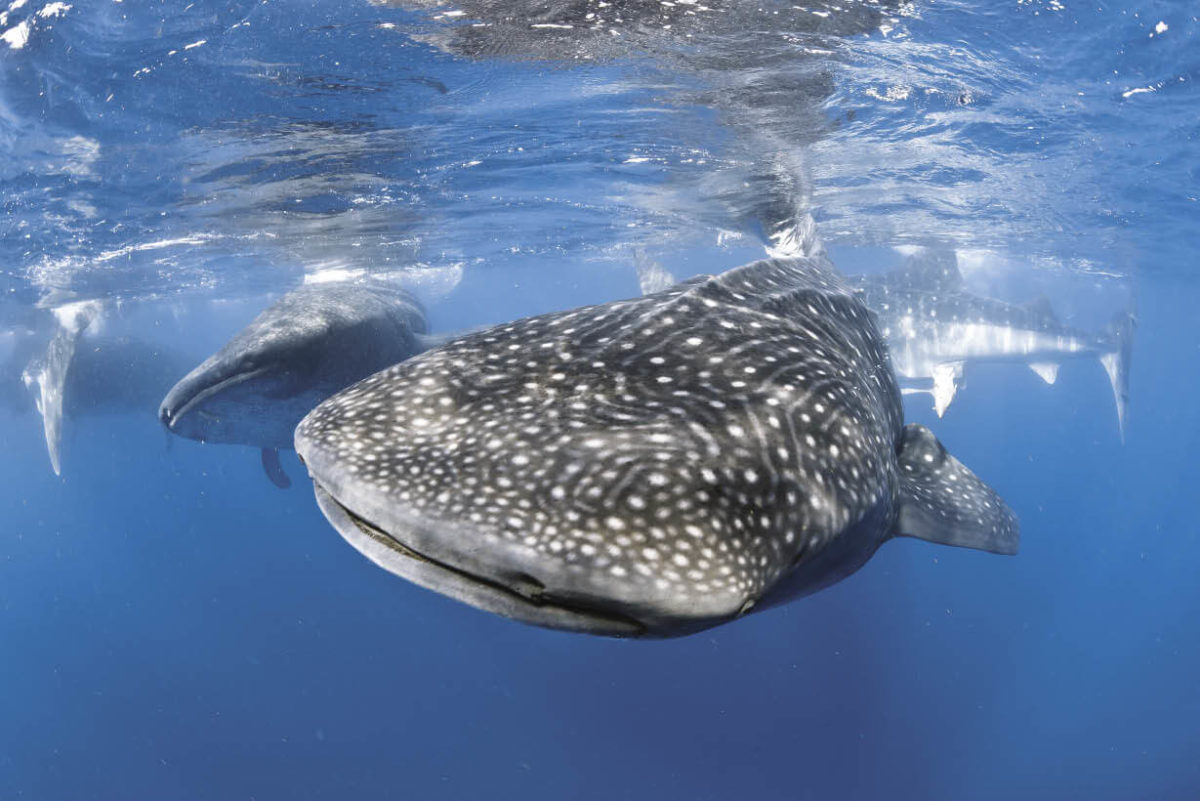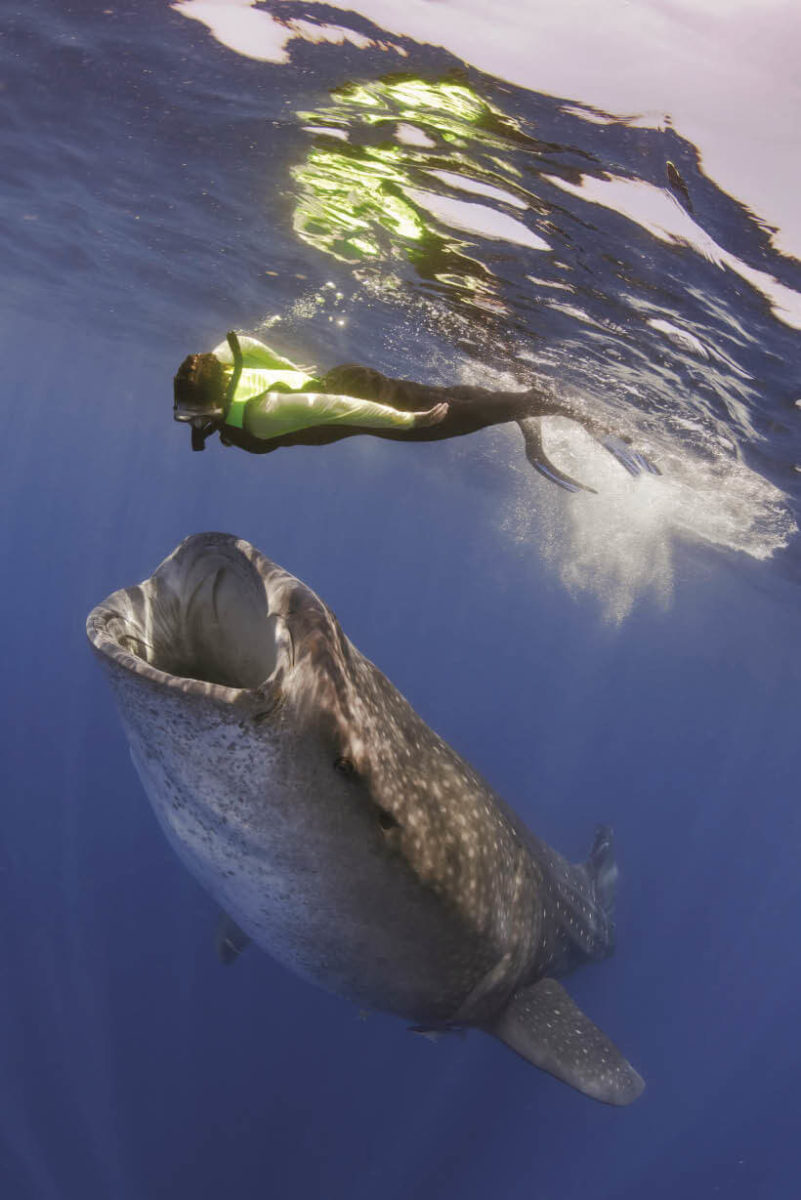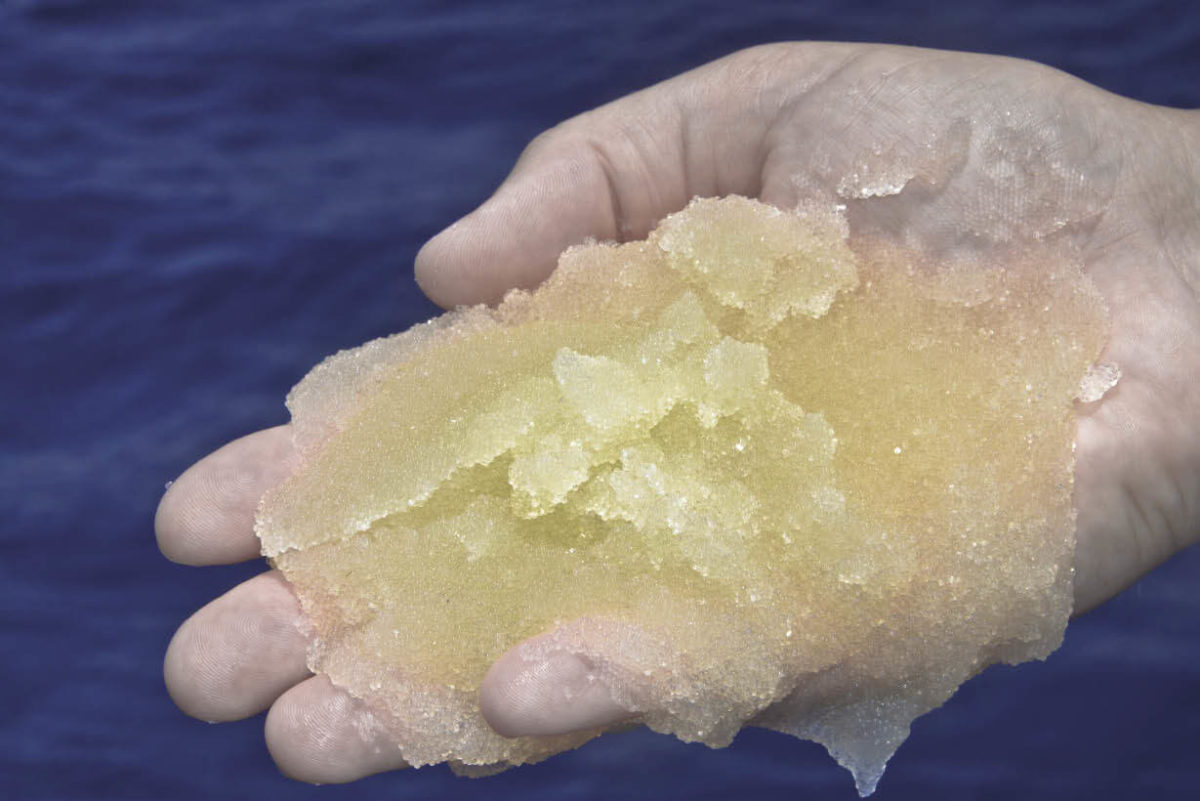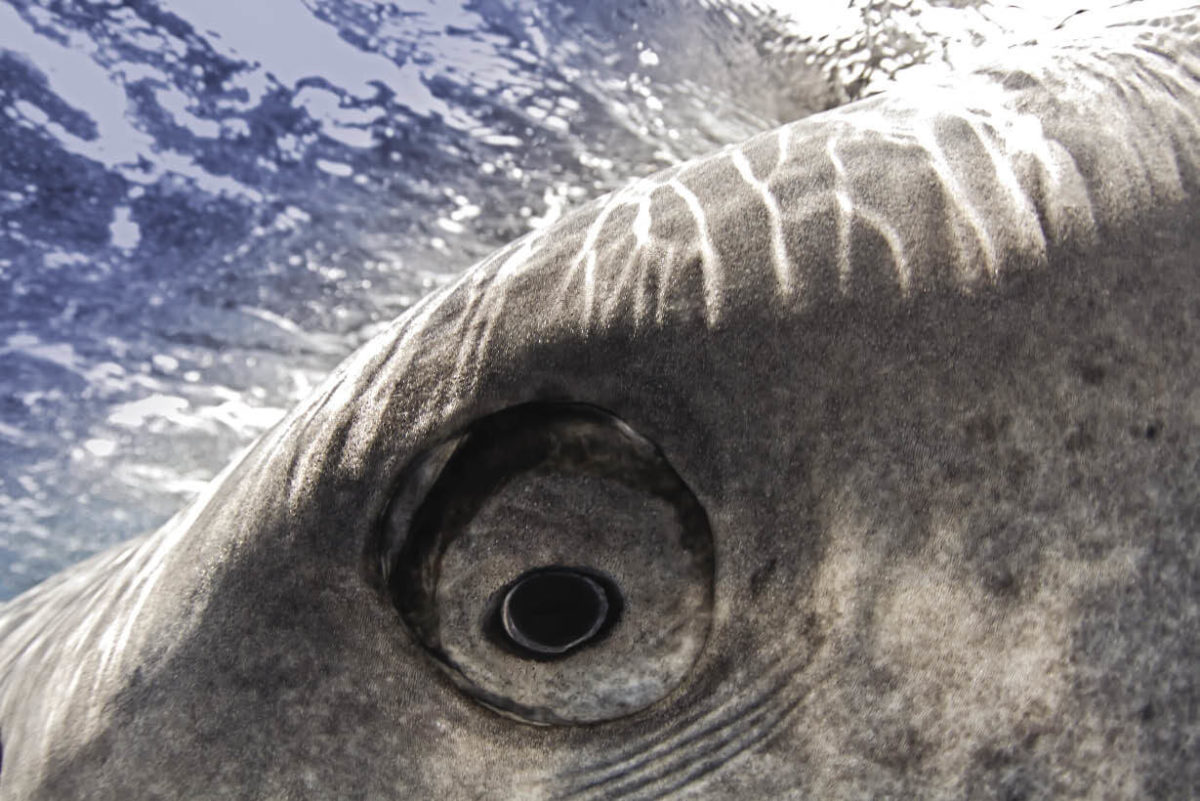
Words and Pictures By Douglas David Seifert
It is now well known that the Mexican waters – especially those around Isla Holbox – offer a good opportunity to encounter whale sharks. Filmmakers and researchers have been documenting gatherings of whale sharks in the Sea of Cortez since the late 1970s, and less than a decade ago, a spectacular seasonal gathering of whale sharks was discovered during the summer months in the shallow waters off the Yucatán Peninsula, near Isla Contoy, off Cabo Catoche.
The news of the aggregation spread far and wide thanks to the immediacy of the internet, and an entire snorkel-with-the-whale-sharks tourism industry has rapidly evolved, transforming the sleepy fishermen’s village of Holbox into a resort destination.
Fortunately, the local and Federal authorities have stepped in and created a Whale Shark Biosphere Reserve, with a code of conduct, rules and regulation, and even occasional enforcement to protect the whale sharks from the over-eager, the incompetent or the reckless, and protect the visiting tourists from unscrupulous, fly-by-night and even dangerous operators.
The relative novelty of ‘snorkelling with the world’s biggest fish!’ – that also happens to be a shark, that can be done in the morning, and allow you back on land in time for the afternoon’s schedule of entertainments, is a bucket list item for many tourists.
The fact that the biggest fish is also a benign, plankton feeder is a bonus and the deal clincher for the overly-cautious, worried about the wisdom of swimming with a shark.
I travelled to Isla Mujeres for DIVE and published a feature about the whale shark aggregation in the greenish, plankton-rich inshore waters of Cabo Catoche.
During the week I experienced the aggregation, there were between 20 and 30 whale sharks at once in an area the size of a football stadium – it was mind-blowing.

Granted, the visibility was not optimal – five to eight metres of limeade-green water was the norm – but it was acceptable. After all, the whale sharks were feeding on the copepods and invertebrates attracted to this phytoplankton bloom.
One day though, there was some oxblood, coffee-coloured water with not even one-metre visibility, which I ducked into and out of promptly (disapproving as I am of things that go bump in the dark when I am in the water). It made me nostalgic for the five-metre, limeade-green water.
Still, seeing so many whale sharks, all day long, day after day, with the appearance of manta rays from time to time and even bottlenose dolphins, this was a slice of heaven down Mexico way.
Not long after I had departed Isla Mujeres to return to the office, because life is cruel and often wicked, word came to me of the discovery of an even larger aggregation of whale sharks, further to the south and further offshore – in blue, deep-ocean waters with visibility reported to be in the 15 – 25m range. And the numbers of whale sharks were said not to be 20 to 30, but nearer a hundred!
My first article was published and that was that. My resolve lasted a full year until I heard reports of hundreds (hundreds!) of whale sharks in blue water. The blue water area these whale sharks were habituating was called the ‘Afuera’ – meaning ‘outside’ because the location was outside the known, shallow, greenish, inshore waters of the newly created Whale Shark Biosphere Reserve.
Interestingly, at the same time, as dozens of whale sharks continued to feed inshore on phytoplankton and copepods and shrimp, the greater number of whale sharks patrolled the deep offshore waters for a different food source: highly-caloric fish eggs.
I had to go back. An opportunity presented itself as two colleagues asked me to escort clients for some trips they had booked in July and August. As the trips were scheduled in the thick of Caribbean hurricane season, I agreed to escort both sets of trips, assuming one or the other might be cancelled by bad weather.
As it turned out, it was a perfectly glorious summer with no real tropical storms, so I ended up spending 25 days, four to five hours a day, snorkelling with whale sharks in blue water with mostly good-to-great visibility.
I had a camera with me at all times – it is force of habit – but after the first few intense hours with literally dozens of whale shark close encounters, one tends to focus less on photography. You lose sense of time and worldly concerns and float in a perfect cocoon of a truly great, out-of-this-world, magical experience.
I did make a few images (okay, a few, er, um, thousand images) but the experience surpassed anything a camera could ever possibly record.



Every morning our boat would depart the wharf near sunrise. The streets of Isla Mujeres were quiet as a ghost town so early in the morning, with the dust barely rising from the pavement in the thin breeze from offshore, and the temperature was still cool.
We would motor out at high speed, heading east-northeast. It would take at least an hour of high-speed travel maybe more, until we reached an area the where the ocean’s ultramarine surface was tempered and discoloured by a wispy gunmetal slick of fish oil: evidence of the fish spawning in the depths below.
The spawning fish were little tunny (Euthynnus alletteratus), a diminutive member of the tuna family not previously known to spawn in Yucatán waters.
But spawn the little tunny do, and in an abundance that is impossible to comprehend. Like most fish, little tunny are broadcast spawners: females eject their eggs by the millions and the males release a cloud of sperm to achieve fertilisation, all the while with both sexes vigorously swimming at a fast pace.
The fertilised eggs then float to the surface. The eggs are buoyant, due to a tiny drop of nutritious oil within the egg that is intended to provide food for the developing embryo until it reaches the developmental stage when it will hatch, drift away with the currents.
The slick-stained surface alerts one to the general area – finding the world’s largest fish is not necessarily an easy exercise in the vast expanse of ocean.
The first whale shark dorsal fin is spotted, breaking the sea’s surface as the shark makes lazy progress through the waters. Its head and upper jaw are frequently out of the water, erupting from the sea’s surface and splashing a forward wake pulse as it moves along its feeding path.
Then more and more of the dark fins become obvious, glistening with beads of seawater and catching the rays of the early morning light.
The boat comes within a reasonable distance and you slide into the water. The depth to the bottom is 30m, but although visibility is good, from top to bottom it is difficult to make out anything deeper than 15 – 20m down. It hardly matters.


The whale sharks are ram filter feeding just below the surface, their mouths agape as they move from one area of concentrated food to the next. This is the most commonly-seen feeding behaviour.
Their silhouettes can be seen at a distance through the blue haze of the limits of visibility. You check which way they are heading and then swim to intersect their path.
Some whale sharks are nonplussed by a snorkeller bobbing in the water; they will swim ahead barely deviating from their course except to avoid a collision with a human who has misjudged their position in the water.
Often, one becomes so focused on watching one whale shark, one doesn’t notice a whale shark coming from one’s blindside. It hardly matters. Whale sharks have an amazing sense of situational awareness and they somehow can avoid hitting even the most intrusive snorkeller with their tail.
A gentle, last-minute flex of their caudal fin leaves barely an inch of water between an 80-kilo stationary human and a 500-kilo rapidly moving whale shark.
Back aboard the boat to take a short break we could watch the show from the surface, which is endlessly fascinating in its own right.
The first thing one notices upon getting out of the water is the preponderance of fish eggs clinging to one’s swimsuit and, well, everywhere. The eggs are small and pale yellow, like a faded caviar, extremely fishy in smell and if one is brave enough to eat some, they are extremely fishy-tasting too.
If one is really lucky, one might witness the most interesting behaviour of all: the botella. Botella means ‘bottle’ in Spanish, and gets its name because, from the flybridge of a fishing boat, the whale shark appears to hang motionless, like a floating bottle.
In fact, the whale shark is hanging vertically in the water, actively sucking in concentrated patches of fish eggs and a tremendous volume of water.
When the whale shark is actively suction feeding, it is so absorbed in its meal that it will tolerate very close approaches by snorkellers and give the opportunity to have an up close and personal view down its cavernous gullet.
During one aerial survey around Isla Holbox, 420 individual whale sharks were seen in the ‘Afuera’ aggregation, an area of 18 square kilometres.
Scientists put the population at perhaps 1,400 whale sharks that visit and are seasonally resident in the waters off the Yucatán and up into the Gulf of Mexico.
So far, of all the whale sharks identified, the sex ratio is 2.8:1 males to females, most of them sexually immature adolescents. It begs the question, since analysis of whale shark paternity indicates births at a 50:50 sex ratio, where are the rest of the females?
The only sour aspect is, of course, the intrusion of fellow man. On any day, 45 to 55 other boats will find the aggregation and turn a lonely piece of ocean into a dangerous parking lot of idling boats. It has become a very big business in the Yucatán and many people are trying to make money as fast as they can, without regard to the experience for the customer or the safety of the animals.
It is actually quite uncommon to see a whale shark that does not have some sort of scar or disfigurement caused by a boat’s propeller or some type of collision. Dorsal fins have gashes and fresh cuts, pieces of tail fins are missing, some animals have open wounds on their back or scrapes furrowing through tough skin which is known to be at least three inches thick.
But it is better to focus on the beauty of the natural experience rather than the ugliness of man’s recklessness. The former is all too rare and the latter all too common.

What we know about whale sharks…
The whale shark’s mouth is wide and capacious, and on the very largest individuals, it may measure up to nearly two metres across. When viewed head-on with its mouth closed, the whale shark’s appearance is reminiscent of those ‘Have a Nice Day!’ emblems of the 1970s – endowing the whale shark with arguably the biggest smile on the planet.
Why should a whale shark have such a big mouth? The whale shark occupies one of nature’s strangest but most wonderful niches: it eats the smallest of creatures – admittedly a tremendous amount of them – in order to attain the greatest of sizes.

It has to continually seek calories wherever it can find them to sustain its metabolic requirements. In order to do so, the whale shark is in a constant state of foraging and will take nutrition in whatever diverse, digestible forms that offer the most nourishment with the least effort.
Plankton generally can be found in relatively dense concentrations, which fulfils the calorific quest without the metabolic cost of energy expended to feed. In addition to plankton, whale sharks have necessarily catholic tastes and will quite willingly take advantage of any seasonal abundance of food such as phytoplankton and zooplankton blooms; coral, invertebrate and fish spawning events; thimble jellyfish concentrations; and squid or small shoaling fish aggregations.
Based on observations of the relatively few captive whale sharks that have been kept over long periods of time in large public aquariums, there appears to be a protracted period of accelerated growth (call it a whale shark growth sprint) built into whale shark natural history to get the animal from a neonate, sized 40–60 centimetres at birth, when it has numerous pelagic predators (such as billfish and large sharks), to a juvenile at three metres, a size large enough that the number of potential predators is far fewer. During this two-and-a-half to three-year high-growth phase, a whale shark may grow close to a metre a year; after it reaches the three metre threshold, the growth rate tends to slow down (at least as observed in aquaria).
Adolescent, sexually immature whale sharks are the whale sharks most commonly encountered, typically from 4m to 7m in length. Mature, adult whale sharks are estimated to average 9 to 10m in length and they are believed to live 60 to 70 years. The largest accurately measured, verifiable whale shark was 12.65m in length, caught in the Arabian Sea, off Pakistan, in 1947.
Often it is written that whale sharks reach much greater lengths – some sources cite whale sharks 18 to 20m in length (or more!), no doubt quoting verbatim the sworn testimony of fishermen and all the reliability that entails, but thus far, no verifiable evidence exists to give any credence to these claims.

With its mouth wide, the whale shark’s small, tennis-ball-sized eyes, which are located slightly further back along its sides, have difficulty seeing directly ahead; the mouth’s width and the separation between the eyes themselves creates a blind spot to a degree. But this hardly affects the shark’s ability to hone in on its prey: at the periphery of the upper jaws are located a pair of what appear to be nostrils and are called ‘barbels’ but are in fact a flap of skin covering the nasal nares – the inlets to the shark’s highly sensitive olfactory sense.
Water-carrying scent molecules pass through their nasal sacs and over a series of skin folds known as olfactory lamellae, where specific odours are analysed and identified as water flows through and out. The substantial distance between the two nasal nares allows the whale shark to fine-tune its internal directional guidance system, letting it adjust its course to wherever it determines the scent is in greatest concentration.
This is vital for an animal seeking its prey by a sense of smell in the aquatic environment. Scent particles in water are carried as amorphous plumes, meandering non-linearly and multi-dimensionally, due to currents and differing densities of water, specific gravity and temperatures. It is helpful to visualise paint swirls on water rather than dandelion seeds carried on the wind, to create a mental picture of how scent molecules move in the realm of water.
The whale shark’s sense of smell, though not well understood, must be one of its main sense to guide its course and determine its energy expenditures to find sufficient concentrations of appropriate prey. The brain of a whale shark, sadly, is not particularly large in the brain-to-body-mass ratio scientists use as guideposts in guesstimating intelligence. One caveat: as a juvenile to adolescent, the brain-to-body mass is quite respectable; over time, however, as the body grows and grows and grows, the brain simply does not keep up with the body that perpetually grows over a lifetime of feeding.
Are whale sharks not terribly intelligent, like cows? Whale sharks do undertake remarkable migrations using navigation clues, scientists with satellite transmitters and time-depth recorders can only guess at. And they are predators, not vegetable browsers. Predation is believed to require more intelligence and skill than grazing (with the exception of most marine ambush predators, for whom patience and persistence have their own rewards).

Three prominent horizontal ridges run the animal’s length along both flanks, punctuating the whale shark’s broad, spindle-shaped body. Its colouration is a dark brown to grey-black base on its dorsal surface and flanks, and it’s vividly patterned by a dreamy checkerboard of dirty white to yellow swirl and dot patterns unique to each individual. Its ventral surface is a chalky white colouration typical of the counter-shading found on many marine animals. The odd pattern on its upper surfaces is referred to as ‘disruptive colouration’, where its markings of lines and blotches visually break up the shape of the animal, creating a camouflage of distractions rather than a recognisable silhouette.

Douglas would like to thank Captain Rogelio Delgado Novelo of the Lilly M and Captain Reuben Pena of the Seahuahua for making great days of whale shark encounters happen and for keeping him and his groups safe from less safety-conscious rival operations, and to his extraordinarily patient hosts on Isla Mujeres at the fabulous Playa Media Luna, operators of Lilly M charters, Kin Lima and Anthony Mendillo (www.islamujeressportfishing.com).


